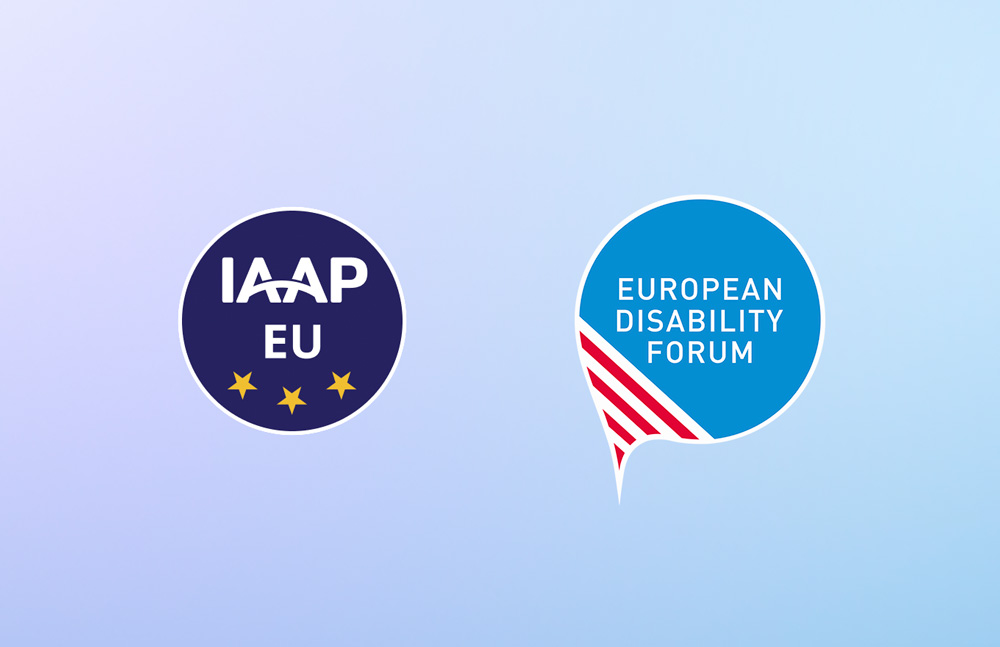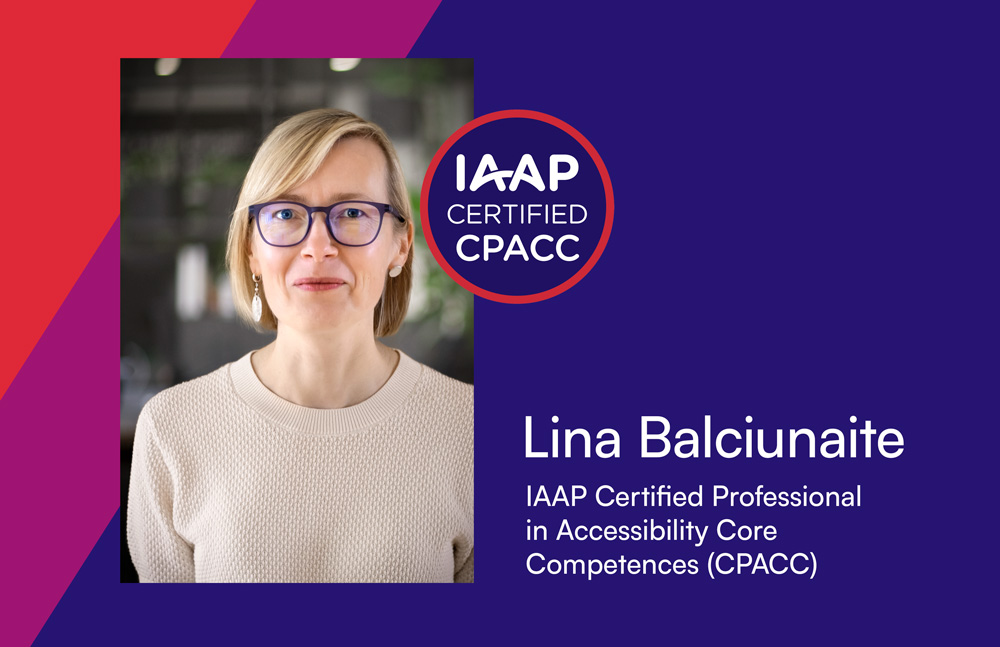Interview with Andzejus Ravanas, Accessibility Specialist and Advocate for the Blind

In today's digital era, ensuring accessibility for all users is crucial to foster an inclusive online environment. To shed light on this matter, we interviewed Andzejus Ravanas, a valuable member of our agency team and a prominent figure in the Lithuanian Union of The Blind and Partially Sighted (LASS).
As a blind user himself, Andzejus brings a unique perspective, understanding the challenges faced by individuals with visual impairments in navigating digital platforms. With his personal journey and professional expertise as an accessibility specialist, he advocates for accessible digital experiences.
In our interview, Andzejus shares insights on the importance of accessibility, the impact of inclusive design, and what businesses are missing by not prioritizing accessibility in their digital products. Join us as we explore the world of accessibility, challenge barriers, and find inspiration to create inclusive digital experiences.
JUNE / KARLOVE: What digital products and services do you primarily use and how do you use them? What factors influenced your choice?
ANDZEJUS: I rely on various digital products and services, but the main ones I use are banking services, food delivery platforms, and ride-hailing services. Like most people, my selection process is based on my needs, but I have an additional criterion: the service must be convenient for screen reader users.
To illustrate, I frequently travel to unfamiliar places, and as a visually impaired person, the most efficient and user-friendly way for me to navigate is by calling a driver. For this purpose, I utilize the Uber platform. While I acknowledge that Uber might be one of the pricier options in Lithuania, it is the most convenient for individuals who rely on screen readers.
I'm willing to pay a few extra euros for a trip to ensure that I can easily communicate with the driver and know their exact location. This guarantees my safety and comfort during the journey.
The same situation applies to banking services and food delivery applications. When I require these services on a regular basis, the price is not always the deciding factor. Often, opting for a cheaper alternative would result in wasting more time and testing my patience while struggling with an app that lacks optimization for screen readers.
JUNE / KARLOVE: Can you provide an example of a situation where you couldn't access a website, digital platform, or digital service? How did this impact your ability to complete a task or make a purchase?
ANZDEJUS: I have personally experienced numerous situations where accessibility barriers hindered my access to digital platforms.
For instance, after a recent update to a banking app, I lost the ability to manage my finances. To make a money transfer, I needed to slide a button that was not optimized for screen reader users, rendering it inaccessible for me.
Similarly, there was a time when I couldn't purchase items from my favorite store due to an update on their website that made the purchasing feature unavailable.
A more concerning example involves my friends who work as massage therapists. They are required to input data into the "Esveikata" (Electronic Health Services of Lithuania) system. However, due to accessibility limitations, screen reader users like myself are unable to accomplish this task independently. Failure to input the required data could potentially lead to a loss of their professional license.

JUNE / KARLOVE: What are the key functions and features that contribute to the accessibility of a website or digital platform for blind and partially sighted users, in your opinion?
ANDZEJUS: The primary feature that enhances accessibility for blind and partially sighted users is adherence to the WCAG (Web Content Accessibility Guidelines) global accessibility standard.
Often, these four letters - WCAG - evoke apprehension among programmers and website/platform owners.
Programmers may feel that implementation is nearly impossible, while owners worry about the associated expenses.
However, these beliefs are myths because creating an accessible product is not overly challenging; it simply requires a little time and patience from programmers and some additional financial resources from the client.
If you offer a marketable product or service, I am confident that the added investment will yield returns within six months and continue to enhance the value of your business.
Regarding accessibility in terms of content, rather than technical aspects, simplicity is the key. Simplicity benefits not only individuals with disabilities but also a broader range of users, including those with dyslexia, elderly people, and non-native speakers.
When visitors come to a website or platform, they seek desired information or wish to order a service with minimal steps and complications. Therefore, complex structures with numerous menu items and sub-items should be avoided. Instead, the product should be informative and straightforward.
By adopting a simple and informative approach, the website or platform becomes accessible for all users.
JUNE / KARLOVE: How do you typically search for products or services when making online purchases? Do you have any specific strategies or tools to simplify the process?
ANDZEJUS: To reiterate, my approach is primarily based on availability and convenience.
Let's say I need to buy a new washing machine. I would begin by opening Google and searching for "washing machine to buy."
Next, I look for the most user-friendly page that is easy to navigate with the assistance of a screen reader.
I specifically seek websites that offer clear headings for convenient navigation through products and provide user-friendly filters for narrowing down options. Once I find such a website, I select the washing machine model that suits my needs and proceed with the purchase.
I must emphasize that even if the same model costs an additional 50 euros at Store X compared to Store Y, I would still choose Store X if their website is more accessible.
The emotional toll and frustration associated with using an inaccessible store, having to input data multiple times, or struggling to interact with checkboxes that are not properly distinguishable outweigh the 50 euros in additional cost.
JUNE / KARLOVE: What message would you like to convey to companies that do not prioritize accessibility in their digital offerings? How can they benefit from making their digital products or services more accessible to people with disabilities?
ANDZEJUS: The message is straightforward: By neglecting accessibility and failing to prioritize its implementation on your website or platform, you are overlooking a significant portion of the market—approximately 10 percent.
In Lithuania alone, official data suggests that around 200,000 people live with disabilities. However, it's important to note that accessibility is not only crucial for individuals with disabilities but also benefits those with dyslexia, seniors, and non-native speakers. Each of these individuals has the potential to become your customer, buyer, or service user.
However, if a competitor offers a more accessible alternative, even at a higher price, they are likely to choose that option instead.
Another common misconception is that people with disabilities solely rely on disability benefits and are often in poverty. This, once again, is a misconception. People with disabilities are frequently skilled professionals and savvy consumers of goods and services.
To attract them, you don't need to brainstorm unique advertising ideas. It's quite simple—create a more accessible product than your competitors.
Implementing accessibility measures in Lithuania is currently easier than ever.
By prioritizing accessibility, companies have the opportunity to tap into a larger customer base, increase sales, and cultivate a positive reputation for inclusivity. It's not just a social responsibility but also a smart business strategy that can yield long-term benefits.
June / Karlove offers accessibility compliance, accessibility knowledge and culture, and accessible design and development services.
Schedule a discovery call to learn how to guarantee your company's digital products are accessible to individuals with disabilities.
Newsletter subscription
Twice a month we send insights, event updates, and valuable resources on best accessibility practices in Lithuania, the Baltics, and the EU market. Subscribe to get the latest knowledge and stay informed.




